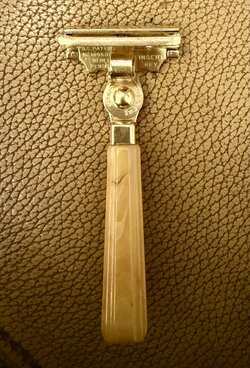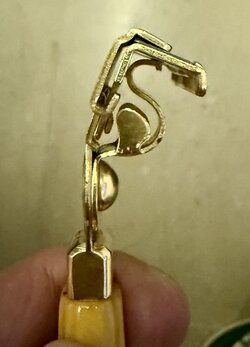Hey guys
Looking for a bit of help here. I recently bought a couple of Injectors. One seems perfectly fine. Have used it as well.
The issue is regarding the other one. It is the one in the pictures. Seems to be a Type E2 maybe as per me since it has only one patent number and no striations on the guard bar like an E3.
But it does not seem to be an openable one to me. Rest you guys can maybe guide better from the pictures.
When I received it, there was quite a bit of rattle in the head. There was no blade inside. I think, being stored for so long without a blade inside may have caused the spring to lose some tension.
Well, I put in a blade and the rattle stopped to quite an extent. But now there was a play in the guard bar.
I referred to a few threads here especially the ones below:
The Eversharp Schick G Type Injector Razor - https://www.badgerandblade.com/forum/threads/the-eversharp-schick-g-type-injector-razor.137589/#google_vignette
Best way to restore schick injector razor - https://www.badgerandblade.com/forum/threads/best-way-to-restore-schick-injector-razor.242253/
A few others as well. Quite informative, really.
After this I wrapped the razor in a cloth and tried to push the base of the spring just above the rivet upwards towards the floating blade plate. Also tried turning it clockwise.
I am specifically using terminology used in the first link just to convey what part I am referring to.
Now the play has reduced somewhat but not by much. Slight play is still there. Basically when I push on the right edge of the guard bar it moves back and the left edge moves forward. And Vice versa.
I would like to ask you fine gents to kindly help me out here. These are my first Injector purchases.
Is there a way to tighten the spring or increase tension?
Is it a problem that can be rectified?
What could be the solution here?
Thanks so much for any help you guys can offer…
Looking for a bit of help here. I recently bought a couple of Injectors. One seems perfectly fine. Have used it as well.
The issue is regarding the other one. It is the one in the pictures. Seems to be a Type E2 maybe as per me since it has only one patent number and no striations on the guard bar like an E3.
But it does not seem to be an openable one to me. Rest you guys can maybe guide better from the pictures.
When I received it, there was quite a bit of rattle in the head. There was no blade inside. I think, being stored for so long without a blade inside may have caused the spring to lose some tension.
Well, I put in a blade and the rattle stopped to quite an extent. But now there was a play in the guard bar.
I referred to a few threads here especially the ones below:
The Eversharp Schick G Type Injector Razor - https://www.badgerandblade.com/forum/threads/the-eversharp-schick-g-type-injector-razor.137589/#google_vignette
Best way to restore schick injector razor - https://www.badgerandblade.com/forum/threads/best-way-to-restore-schick-injector-razor.242253/
A few others as well. Quite informative, really.
After this I wrapped the razor in a cloth and tried to push the base of the spring just above the rivet upwards towards the floating blade plate. Also tried turning it clockwise.
I am specifically using terminology used in the first link just to convey what part I am referring to.
Now the play has reduced somewhat but not by much. Slight play is still there. Basically when I push on the right edge of the guard bar it moves back and the left edge moves forward. And Vice versa.
I would like to ask you fine gents to kindly help me out here. These are my first Injector purchases.
Is there a way to tighten the spring or increase tension?
Is it a problem that can be rectified?
What could be the solution here?
Thanks so much for any help you guys can offer…









